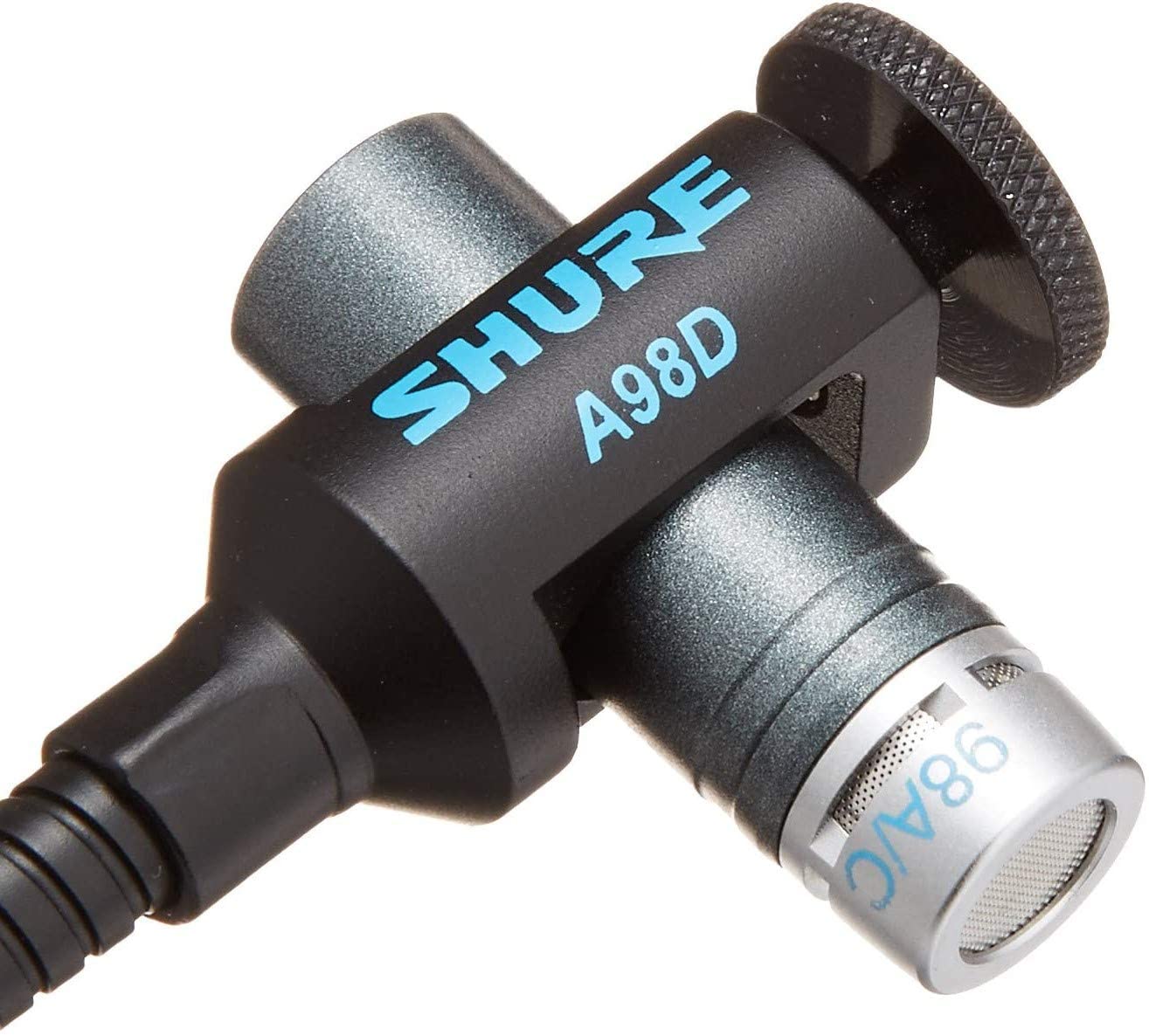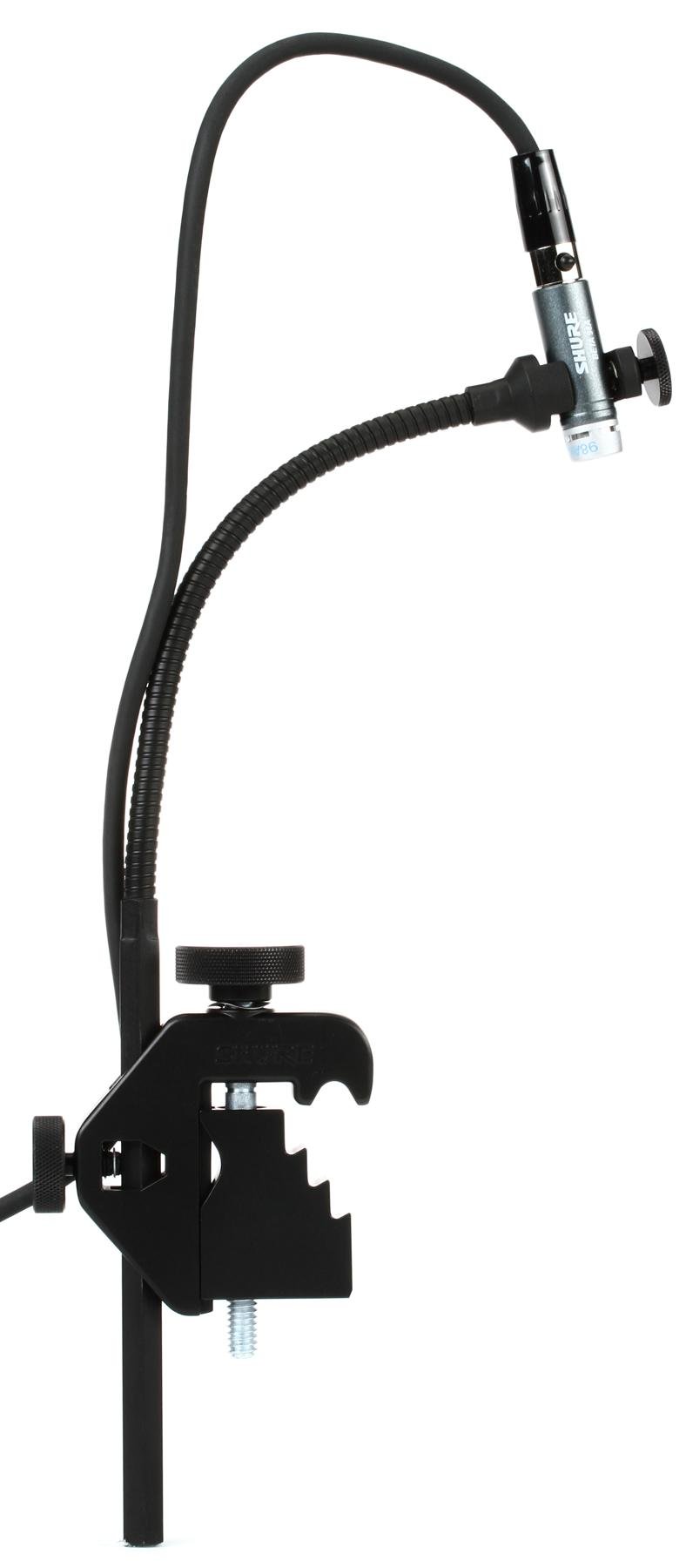Description
The Shure Beta 98A is a precision-engineered compact, high-output miniature condenser microphone for professional sound reinforcement and studio recording. An extremely uniform cardioid polar pattern provides excellent gain-before-feedback and off-axis rejection of unwanted noise.
Both Beta 98A configurations feature high sound pressure level capability (SPL). Beta 98AD/C includes A98D drum mount with flexible gooseneck that makes it an essential, accurate choice for toms, snares, and percussion. Beta 98A/C is recommended for a variety of acoustic or amplified instruments including drums, piano, reed, wind, and strings.
- Uniform cardioid polar pattern provides maximum gain-before-feedback and rejection of off-axis sound for smooth high-end response and control
- Frequency response tailored for drums and percussion applications with a wide dynamic range for use in high SPL environments
- Precision-engineered design for unobtrusive microphone footprint
- Beta 98A models ship with external in-line preamplifier for discreet cable placement, snap-fit windscreen, and zipper pouch
- Beta 98AD/C ships with A98D drum mount featuring a flexible gooseneck for precise placement and secure attachment
- Beta 98A/C ships with RK282 shock mount swivel adapter for attachment to any standard microphone stand
PRODUCT DETAILS
What is the Beta 98AD/C best suited to?
This premium drum microphone is ideal for use with snares, toms and percussion.
What are the characteristics of the Beta 98AD/C?
An extremely uniform cardioid polar pattern provides excellent gain-before-feedback and off axis rejection of unwanted noise.
What is the difference between the Beta 98AD/C and the other versions of the Beta 98?
The Beta 98AD/C is a cardioid condenser drum microphone and comes complete with the A98D drum mount which features a flexible gooseneck. The Beta 98A/C is the same microphone minus the drum mount. The Beta 98 AMP/C features an integrated preamplifier.
Also available are supercardioid versions (Beta 98S & Beta 98D/S).
Please note - any Beta drum microphone featuring the letter 'A' following the model number contains a new capsule and as a result you can expect a more natural high frequency response.
- Uniform cardioid polar pattern provides with smooth high-end response
- Frequency response tailored for drums and percussion applications with a wide dynamic range for use in high SPL environments
- Precision-engineered design for unobtrusive microphone footprint
- Ships with A98D Drum mount featuring a flexible gooseneck for precise placement and secure attachment
General Description
The Shure Beta 98A is a compact, high-output, condenser microphone for professional sound reinforcement and studio recording. An extremely uniform cardioid polar pattern provides excellent gain before feedback and off-axis rejection of unwanted noise. Its high sound pressure level (SPL) capability makes it useful for a variety of acoustic or amplified instruments including drums, piano, reed, wind, and strings.
Variations
- Beta 98A/C includes microphone, 7.6 m (25 ft) light-weight interconnect cable, preamplifier, and RK282 shockmount swivel adapter.
- Beta 98AD/C includes microphone, 4.6 m (15 ft) heavy-duty interconnect cable, preamplifier, and A98D microphone drum mount.
Performance Characteristics
- Exceptional low-frequency reproduction
- Extremely high SPL handling
- High output level
- No crossover distortion
Features
- Premier live performance microphone with Shure quality, ruggedness, and reliability
- Uniform cardioid pick-up pattern for maximum gain before feedback and superior rejection of off-axis sound
- Tailored frequency response specifically shaped for drums, percussion, reeds, and horns
- Compact design reduces stage clutter
- Wide dynamic range for use in high SPL environments
- Optional A98D mount is unobtrusive, versatile, and easy to adjust
- Enamel-coated metal construction and stainless steel inner grille resist wear and abuse
Interconnecting Cable
The supplied cable connects the BETA 98A to the preamplifier. If necessary, up to 23 m (75 ft) of cable can be used between the microphone and preamplifier without signal loss.
Applications
General Rules for Use
- Do not cover any part of the microphone grille with your hand, as this will adversely affect microphone performance.
- Aim the microphone toward the desired sound source (such as the talker, singer, or instrument) and away from unwanted sources.
- Place the microphone as close as practical to the desired sound source.
- Work close to the microphone for extra bass response.
- Use only one microphone to pick up a single sound source.
- For better gain before feedback, use fewer microphones.
- Keep the distance between microphones at least three times the distance from each microphone to its source (“three to one rule”).
- Place microphones as far as possible from reflective surfaces.
- Add a windscreen when using the microphone outdoors.
- Avoid excessive handling to minimize pickup of mechanical noise and vibration.
Applications and Placement
The following table lists the most common applications and placement techniques. Keep in mind that microphone technique is largely a matter of personal taste; there is no one "correct" microphone position.
| Application | Suggested Microphone Placement | Tone Quality |
|---|---|---|
| Tom-Toms | One mic on each tom or between a pair of toms, 2.5 to 7.5 cm (1 to 3 in.) above drum heads. | Medium attack; full, balanced sound. |
| Remove bottom head and place a mic inside pointing up toward top drum head. | Maximum isolation; full, balanced sound. | |
| Snare Drum | 2.5 to 7.5 cm (1 to 3 in.) above rim of top head of drum. Aim mic at drum head. | Most "snap" from drumstick. |
| Cymbals | Close-mike with an A98D mount for maximum isolation, but place out of cymbal movement range. | Bright, with plenty of attack. |
| Brass & Woodwinds | Brass: 30 to 90 cm (1 to 3 ft.) away, on-axis with bell of instrument. | Bright, clear sound. |
| Woodwinds: 2.5 to 15 cm (1 to 6 in.) away, on-axis with bell of instrument. | Bright, clear sound. | |
| Bell of instrument 90° off-axis from front of mic. | Softer, mellow sound. |
Note: Before each use, make sure the cartridge is tightly secured on the microphone, as vibration and accidental hits with drumsticks may loosen it, resulting in signal loss.
Shockmount Swivel Adapter
Use the following procedures to mount the Beta 98A on the swivel adapter:
- Connect the microphone to the adapter.
- Thread the cable through the C-clamp and slide the connector into the C-clamp until snug.
- To reduce wear on the cable, snap it into the stress reliever clip leaving 5 to 7 cm (2 to 3 inches) of slack on the connector side.

BETA 98A MOUNTED WITH SWIVEL ADAPTER
A98D Drum Mount
The Shure A98D mounts the Beta 98A on a drum or cymbal stand. Reference the furnished A98D guide to correctly mount the microphone.

BETA 98A MOUNTED WITH A98D
Load Impedance
Maximum SPL capability, output clipping level, and dynamic range vary with the input load impedance of the preamplifier to which the microphone is connected. Shure recommends a minimum input load impedance of 1000 Ohms. Most modern microphone preamplifiers meet this requirement. Higher impedance results in better performance for these specifications.
Power Requirements
This microphone requires phantom power and performs best with a 48 Vdc supply (IEC-61938). However, it will operate with slightly decreased headroom and sensitivity with supplies as low as 11 Vdc.
Most modern mixers provide phantom power. You must use a balanced microphone cable: XLR-to-XLR.
Specifications
Type
Electret Condenser
Frequency Response
20 to 20,000 Hz
Polar Pattern
Cardioid
Output Impedance
at 1kHz
179 Ω
Sensitivity
at 1kHz, open circuit voltage, typical
-48.0 dBV/Pa (4.0 mV) [1]
Maximum SPL
1 kHz at 1% THD [2]
| 2500 Ω load | 150.5 dB |
| 1000 Ω load | 144.0 dB |
Signal-To-Noise Ratio [3]
64 dB
Dynamic Range
at 1kHz
| 2500 Ω load | 120.5 dB |
| 1000 Ω load | 114.0 dB |
Clipping Level
20 Hz to 20 kHz, at 1% THD
| 2500 Ω load | 8.0 dBV |
| 1000 Ω load | 1.0 dBV |
Self Noise
equivalent SPL, A-weighted, typical
30.0 dB SPL-A
Connector
Three-pin professional audio (XLR), male, balanced
Power Requirements
11–52 V DC phantom power [4], 3.6 mA
Polarity
Positive pressure on diaphragm produces positive voltage on pin 2 with respect to pin 3
Weight
12 g (0.6oz.)
[1]1 Pa=94 dB SPL
[2]THD of microphone preamplifier when applied input signal level is equivalent to cartridge output at specified SPL
[3]S/N ratio is the difference between 94 dB SPL and equivalent SPL of self-noise, A-weighted
[4]All specifications measured with a 48 Vdc phantom power supply. The microphone operates at lower voltages, but with slightly decreased headroom and sensitivity

Internal Connections

Typical Frequency Response

Typical Polar Patterns

Overall Dimensions
Accessories
Furnished Accessories
| Zippered Carrying Bag | 95A2314 |
| In-Line Microphone Preamplifier for WBH53 (BETA53), WBH54 (BETA54), BETA91, WB98H/C (BETA98), MC50B, MC51B and SM35-XLR | RPM626 |
| Snap-fit Windscreen | 95A2064 |
| BETA98/S Stand Adapter with Integral Shock Mount | RK282 |
| Zippered Carrying Bag | 95A2398 |
| Microphone Drum Mount for BETA98 & SM98A Microphones, Features Gooseneck Adapter for Flexible Positioning | A98D |
| 15'Triple-Flex™ Cable (TA3F to TA4F) for BETA91, BETA98/S, BETA98D/S | C98D |





